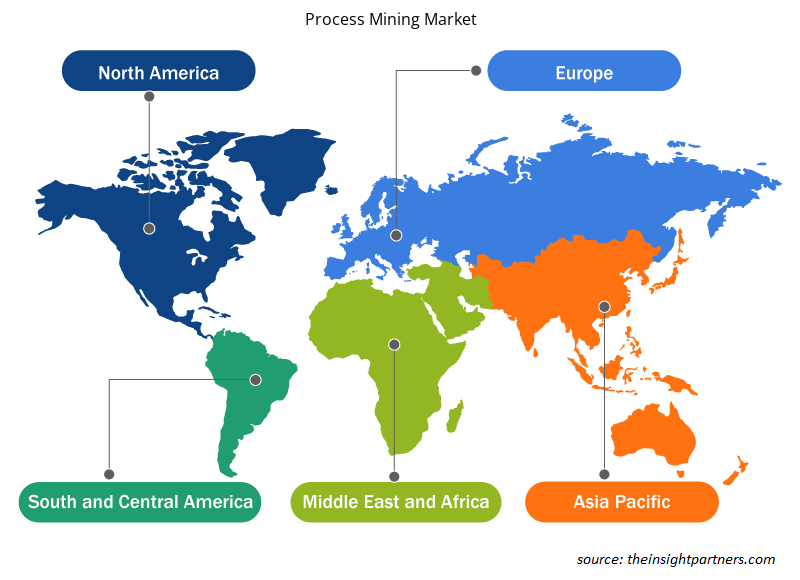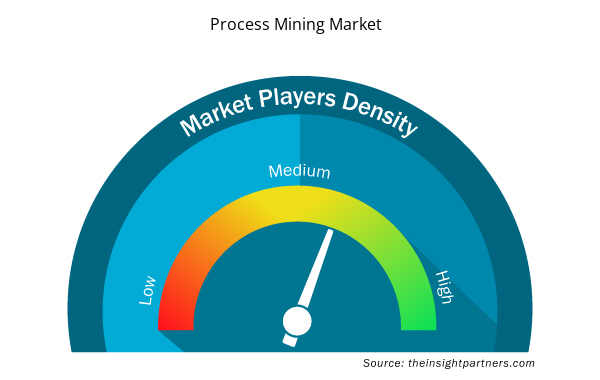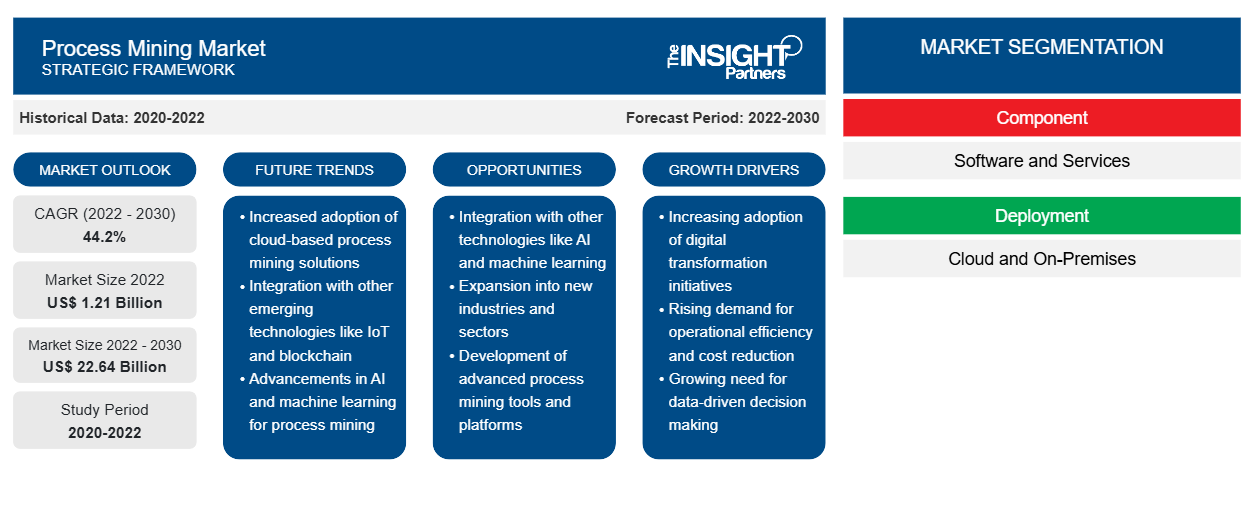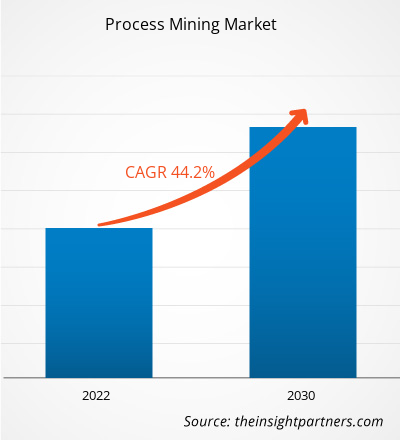[Forschungsbericht] Der Markt für Process Mining soll von 1,21 Milliarden US-Dollar im Jahr 2022 auf 22,64 Milliarden US-Dollar im Jahr 2030 wachsen; von 2022 bis 2030 wird eine durchschnittliche jährliche Wachstumsrate (CAGR) von 44,2 % erwartet.
Perspektive eines Process-Mining-Marktanalysten:
Der Bedarf an Process-Mining-Software wird durch die wachsende Notwendigkeit für Unternehmen getrieben, ihre Prozessprüfungen und Compliance-Verfahren zu verbessern. Die zunehmende Nutzung von Cloud-Lösungen und -Diensten, digitale Transformationsprojekte und ein erhöhter Bedarf, organisatorische Geschäftsprozesse zu verstehen und zu analysieren, sind einige der Faktoren, die den Markt antreiben. Die COVID-19-Pandemie veranlasste viele Unternehmen, von On-Premise- auf Cloud-Computing umzusteigen, was zu einer Ausweitung des Marktanteils im Bereich Process Mining führte .
Unternehmen nutzen Technologie- und Softwarelösungen, um ihre Geschäftsabläufe zu verbessern und bei einer Reihe von Verfahren Effizienz zu erzielen. Sie werden immer digitaler und agiler. Lösungen wie Process Mining integrieren Data Mining und Prozessanalyse, um Unternehmen dabei zu helfen, detaillierte Informationen aus ihren Aufzeichnungssystemen abzurufen. Durch die Möglichkeit, Prozesse zu visualisieren, sind Unternehmen besser in der Lage, ihre aktuellen Prozesse zu beurteilen und bessere Geschäftspläne durch Managementteams in die Tat umzusetzen. Darüber hinaus hilft es Unternehmen dabei, Bereiche für Automatisierung und Optimierung zu identifizieren. Schon bald werden Process-Mining-Softwareunternehmen erhebliche Wachstumsaussichten haben, da sie Spitzentechnologien wie künstliche Intelligenz (KI) und maschinelles Lernen (ML) in die Software integrieren. Daher wird erwartet, dass die Integration von Technologien wie künstlicher Intelligenz (KI) und maschinellem Lernen (ML) neue Trends im Process-Mining-Markt mit sich bringen wird.
Marktübersicht Process Mining:
Process Mining ist eine Methode zur Überwachung, Analyse und Verbesserung von Prozessen. Process Mining ist ein Ansatz, der öffentlich verfügbares Wissen aus Ereignisprotokollen von Informationssystemen nutzt, um reale Geschäftsprozesse zu finden, zu verfolgen und zu verbessern. Process Mining unterstützt Unternehmen dabei, die Prozesse, die ihre Kunden unterstützen, vollständig zu verstehen. Process Mining umfasst die automatische Identifizierung und Extraktion von Prozessen, die Überwachung der Compliance, das Mining sozialer Netzwerke, den automatischen Aufbau von Simulationsmodellen und die Bereitstellung von Empfehlungen auf Grundlage der Erweiterung und Reparatur historischer Modelle.
Kunden können Process Mining nutzen, um Probleme mit ihren Geschäftsprozessen zu finden und eine priorisierte Liste der teuersten Ineffizienzen in ihren Unternehmen zu erstellen. Process Mining steigert die Produktivität durch Prozessvereinfachung, Verbesserung der Zykluszeit und Beseitigung von Engpässen; senkt die Kosten für Wiederholungen, Nacharbeit und manuelle Verfahren; verbessert die Compliance durch Identifizierung betrügerischer oder nicht konformer Verfahren; bietet Geschäftsoptimierung durch Prozessverbesserung und Echtzeitüberwachung; und bietet bessere kundenorientierte Prozesse, die zu höherer Kundenzufriedenheit und besserem Service führen.
Angesichts der zunehmenden Komplexität betrieblicher Abläufe und des technologischen Fortschritts ist Process Mining in zahlreichen Branchen zu einer wichtigen Lösung zur Verbesserung der Prozessabläufe geworden.
Passen Sie diesen Bericht Ihren Anforderungen an
Sie erhalten kostenlos individuelle Anpassungen an jedem Bericht, einschließlich Teilen dieses Berichts oder einer Analyse auf Länderebene, eines Excel-Datenpakets sowie tolle Angebote und Rabatte für Start-ups und Universitäten.
- Holen Sie sich die wichtigsten Markttrends aus diesem Bericht.Dieses KOSTENLOSE Beispiel umfasst eine Datenanalyse von Markttrends bis hin zu Schätzungen und Prognosen.
Markttreiber für Process Mining:
Zunehmende Komplexität der Geschäftsprozesse treibt das Wachstum des Process Mining-Marktes im Prognosezeitraum voran
Geschäftskomplexität bezieht sich auf die Bildung eines großen, vernetzten Netzwerks aus Technologien, Daten, Produkten oder Dienstleistungen und Menschen innerhalb einer Organisation. Je größer das Unternehmen, desto komplexer wird das Geschäft. Heutzutage müssen Unternehmen eine immer größere Anzahl von Tools und Daten verwalten, was sie komplexer macht. Gleichzeitig ändern sich Marktbedingungen und Arbeitsumgebungen schneller als je zuvor, sodass Unternehmen schnell reagieren und Entscheidungen treffen müssen. Um effektiv auf Veränderungen reagieren zu können, müssen Unternehmen ihre Prozesse, Tools und Daten genau verstehen.
Darüber hinaus kann es für einige Unternehmen aufgrund des komplexen Geflechts miteinander verbundener Daten, Technologien und Prozesse schwierig sein, zu verstehen, wie sich verschiedene Teile gegenseitig beeinflussen und welche für den Betrieb wesentlich sind. Unternehmen stehen unter enormem Druck, sich an diese Mischung aus beschleunigtem Wandel und größerer Komplexität anzupassen. Um auf dem Markt wettbewerbsfähig zu bleiben, müssen Unternehmen die geschäftliche Komplexität verdeutlichen. Viele Unternehmen sind aufgrund der COVID-19-Pandemie heute mit einer höheren Komplexität konfrontiert als noch vor einigen Jahren. Die COVID-19-Pandemie beschleunigte den Wandel der Geschäftsprozesse und erforderte von den Unternehmen, sich schnell an einen neuen Markt anzupassen, neue Tools zur Unterstützung einer Remote-Belegschaft bereitzustellen und ihre Bemühungen zur digitalen Transformation zu verstärken. Der Fokus auf die Digitalisierung bleibt für Unternehmen heutzutage eine Priorität. All diese Faktoren erhöhen die Komplexität der Geschäftsprozesse innerhalb einer Organisation. Wenn das Geschäft wächst, ist es entscheidend, die Komplexität zu vereinfachen, um die Produktivität zu steigern, Innovationen zu skalieren und das Risiko zu senken.
Process Mining hat sich als nützliches Tool erwiesen, um den aktuellen Stand der Geschäftsprozessleistung zu bewerten, Verbesserungsbereiche zu identifizieren und die Ergebnisse von Prozessverbesserungen zu bewerten. Somit treibt die zunehmende Komplexität von Geschäftsprozessen das Wachstum des Process Mining-Marktes voran.
Segmentierung und Umfang des Process-Mining-Marktberichts:
Die Marktanalyse für Process Mining wurde unter Berücksichtigung der folgenden Segmente durchgeführt: Komponente, Bereitstellung, Unternehmensgröße, Branche und Geografie. Basierend auf der Komponente ist der Markt in Software und Dienste unterteilt. Nach Bereitstellung ist der Markt in Cloud und On-Premise unterteilt. In Bezug auf die Unternehmensgröße ist der Markt in Großunternehmen und KMU unterteilt. Basierend auf der Branche ist der Markt in IT und Telekommunikation, BFSI, Fertigung, Einzelhandel und E-Commerce , Gesundheitswesen und andere unterteilt. Geografisch ist der Markt in Nordamerika, Europa, Asien-Pazifik, den Nahen Osten und Afrika sowie Südamerika unterteilt.
Segmentanalyse des Process Mining-Marktes:
Basierend auf der Bereitstellung hielt das Cloud-Segment einen größeren Marktanteil im Bereich Process Mining. Cloud-basierte Lösungen bieten umfangreichere, personalisiertere Dienste als On-Premise-Lösungen, wie z. B. zentralisierte Benutzerzusammenarbeit, Messaging und Warnfunktionen. Mit diesen Vorteilen bieten Cloud-basierte Lösungen Unternehmen auch wirtschaftliche und technische Vorteile, z. B. dass sie die Notwendigkeit beseitigen, in eine IT-Infrastruktur zu investieren und diese zu warten und voneinander abhängige Software-Release-Zyklen zu vermeiden.
Analyse der Marktteilnehmer für Process Mining:
Celonis SE; IBM Corporation; Software AG; QPR Software; Hyland Software, Inc.; UiPath; Cloud Software Group, Inc (TIBCO Software); ABBYY; Microsoft; und Fluxicon BV gehören zu den wichtigsten Akteuren, die im Bericht zum Process-Mining-Markt vorgestellt werden.
Regionale Einblicke in den Process-Mining-Markt
Die regionalen Trends und Faktoren, die den Process Mining-Markt im Prognosezeitraum beeinflussen, wurden von den Analysten von Insight Partners ausführlich erläutert. In diesem Abschnitt werden auch die Marktsegmente und die Geografie des Process Mining in Nordamerika, Europa, im asiatisch-pazifischen Raum, im Nahen Osten und Afrika sowie in Süd- und Mittelamerika erörtert.

- Holen Sie sich die regionalspezifischen Daten für den Process Mining-Markt
Umfang des Process Mining-Marktberichts
| Berichtsattribut | Details |
|---|---|
| Marktgröße im Jahr 2022 | 1,21 Milliarden US-Dollar |
| Marktgröße bis 2030 | 22,64 Milliarden US-Dollar |
| Globale CAGR (2022 - 2030) | 44,2 % |
| Historische Daten | 2020-2022 |
| Prognosezeitraum | 2022–2030 |
| Abgedeckte Segmente | Nach Komponente
|
| Abgedeckte Regionen und Länder | Nordamerika
|
| Marktführer und wichtige Unternehmensprofile |
|
Dichte der Marktteilnehmer im Process Mining: Die Auswirkungen auf die Geschäftsdynamik verstehen
Der Process Mining-Markt wächst rasant, angetrieben durch die steigende Endverbrauchernachfrage aufgrund von Faktoren wie sich entwickelnden Verbraucherpräferenzen, technologischen Fortschritten und einem größeren Bewusstsein für die Vorteile des Produkts. Mit steigender Nachfrage erweitern Unternehmen ihr Angebot, entwickeln Innovationen, um die Bedürfnisse der Verbraucher zu erfüllen, und nutzen neue Trends, was das Marktwachstum weiter ankurbelt.
Die Marktteilnehmerdichte bezieht sich auf die Verteilung der Firmen oder Unternehmen, die in einem bestimmten Markt oder einer bestimmten Branche tätig sind. Sie gibt an, wie viele Wettbewerber (Marktteilnehmer) in einem bestimmten Marktraum im Verhältnis zu seiner Größe oder seinem gesamten Marktwert präsent sind.
Die wichtigsten auf dem Process-Mining-Markt tätigen Unternehmen sind:
- Celonis SE
- IBM Corporation
- Software AG
- QPR Software
- Hyland Software, Inc.
Haftungsausschluss : Die oben aufgeführten Unternehmen sind nicht in einer bestimmten Reihenfolge aufgeführt.

- Überblick über die wichtigsten Akteure auf dem Process-Mining-Markt
Jüngste Entwicklungen im Process-Mining-Markt:
Die Marktprognose für Process Mining kann den Beteiligten in diesem Markt bei der Planung ihrer Wachstumsstrategien helfen. Anorganische und organische Strategien wie Fusionen und Übernahmen werden von den Marktteilnehmern häufig eingesetzt, um ihre Position im Process Mining-Markt zu behaupten. Nachfolgend sind einige aktuelle Schlüsselentwicklungen aufgeführt:
- Im September 2023 sind QPR Software und Novacon eine Partnerschaft eingegangen, um Process-Mining-Lösungen in Ungarn zu transformieren. Diese Partnerschaft kombiniert Novacons umfassende Erfahrung im Lean Management und in der Prozessautomatisierung mit QPRs hochmodernem Process-Mining-Wissen und der Software QPR ProcessAnalyzer.
- Im Mai 2023 kündigte Celonis die Einführung neuer Process-Mining-Innovationen an, um Kunden schnell einen substanziellen Mehrwert zu bieten. Diese neuen Produktfunktionen ermöglichen es Unternehmen, innerhalb ihrer Prozesse schnell geschäftlichen Mehrwert zu finden und zu erfassen.
- Im Mai 2023 kündigte Pegasystems Inc. die Einführung von Pega Process Mining mit generativen KI-fähigen APIs an, um eine kontinuierliche Workflow-Optimierung zu ermöglichen. Diese neuen Process-Mining-Funktionen erleichtern es Pega-Benutzern aller Erfahrungsstufen, Prozessineffizienzen zu finden und zu beheben, die ihren Geschäftsbetrieb behindern könnten.
- Historische Analyse (2 Jahre), Basisjahr, Prognose (7 Jahre) mit CAGR
- PEST- und SWOT-Analyse
- Marktgröße Wert/Volumen – Global, Regional, Land
- Branche und Wettbewerbsumfeld
- Excel-Datensatz


- Queue Management System Market
- Aircraft Landing Gear Market
- Europe Surety Market
- Electronic Toll Collection System Market
- Nitrogenous Fertilizer Market
- Vision Guided Robotics Software Market
- Pressure Vessel Composite Materials Market
- Aesthetic Medical Devices Market
- Identity Verification Market
- Vertical Farming Crops Market

Report Coverage
Revenue forecast, Company Analysis, Industry landscape, Growth factors, and Trends

Segment Covered
This text is related
to segments covered.

Regional Scope
North America, Europe, Asia Pacific, Middle East & Africa, South & Central America

Country Scope
This text is related
to country scope.
Häufig gestellte Fragen
Increasing complexity of business processes and huge digital transformation across enterprises are the driving factors impacting the process mining market grrowth.
The process mining was valued at US$ 1.21 billion in 2022 and is projected to reach US$ 22.64 billion by 2030; it is expected to grow at a CAGR of 44.2% during 2022–2030.
Cloud based process mining solutions is the future trend of the process mining market.
The key players, holding majority shares, in process mining includes Celonis SE, UiPath, Software AG, IBM Corporation, and Hyland Software, Inc. among others.
The Europe held the largest market share in 2022, followed by North America and Asia Pacific.
Europe is anticipated to grow with the highest CAGR over the forecast period.
Trends and growth analysis reports related to Technology, Media and Telecommunications : READ MORE..
The List of Companies - Process Mining Market
- Celonis SE
- IBM Corporation
- Software AG
- QPR Software
- Hyland Software, Inc.
- UiPath
- Cloud Software Group, Inc (TIBCO Software)
- ABBYY
- Microsoft
- Fluxicon BV
The Insight Partners performs research in 4 major stages: Data Collection & Secondary Research, Primary Research, Data Analysis and Data Triangulation & Final Review.
- Data Collection and Secondary Research:
As a market research and consulting firm operating from a decade, we have published and advised several client across the globe. First step for any study will start with an assessment of currently available data and insights from existing reports. Further, historical and current market information is collected from Investor Presentations, Annual Reports, SEC Filings, etc., and other information related to company’s performance and market positioning are gathered from Paid Databases (Factiva, Hoovers, and Reuters) and various other publications available in public domain.
Several associations trade associates, technical forums, institutes, societies and organization are accessed to gain technical as well as market related insights through their publications such as research papers, blogs and press releases related to the studies are referred to get cues about the market. Further, white papers, journals, magazines, and other news articles published in last 3 years are scrutinized and analyzed to understand the current market trends.
- Primary Research:
The primarily interview analysis comprise of data obtained from industry participants interview and answers to survey questions gathered by in-house primary team.
For primary research, interviews are conducted with industry experts/CEOs/Marketing Managers/VPs/Subject Matter Experts from both demand and supply side to get a 360-degree view of the market. The primary team conducts several interviews based on the complexity of the markets to understand the various market trends and dynamics which makes research more credible and precise.
A typical research interview fulfils the following functions:
- Provides first-hand information on the market size, market trends, growth trends, competitive landscape, and outlook
- Validates and strengthens in-house secondary research findings
- Develops the analysis team’s expertise and market understanding
Primary research involves email interactions and telephone interviews for each market, category, segment, and sub-segment across geographies. The participants who typically take part in such a process include, but are not limited to:
- Industry participants: VPs, business development managers, market intelligence managers and national sales managers
- Outside experts: Valuation experts, research analysts and key opinion leaders specializing in the electronics and semiconductor industry.
Below is the breakup of our primary respondents by company, designation, and region:

Once we receive the confirmation from primary research sources or primary respondents, we finalize the base year market estimation and forecast the data as per the macroeconomic and microeconomic factors assessed during data collection.
- Data Analysis:
Once data is validated through both secondary as well as primary respondents, we finalize the market estimations by hypothesis formulation and factor analysis at regional and country level.
- Macro-Economic Factor Analysis:
We analyse macroeconomic indicators such the gross domestic product (GDP), increase in the demand for goods and services across industries, technological advancement, regional economic growth, governmental policies, the influence of COVID-19, PEST analysis, and other aspects. This analysis aids in setting benchmarks for various nations/regions and approximating market splits. Additionally, the general trend of the aforementioned components aid in determining the market's development possibilities.
- Country Level Data:
Various factors that are especially aligned to the country are taken into account to determine the market size for a certain area and country, including the presence of vendors, such as headquarters and offices, the country's GDP, demand patterns, and industry growth. To comprehend the market dynamics for the nation, a number of growth variables, inhibitors, application areas, and current market trends are researched. The aforementioned elements aid in determining the country's overall market's growth potential.
- Company Profile:
The “Table of Contents” is formulated by listing and analyzing more than 25 - 30 companies operating in the market ecosystem across geographies. However, we profile only 10 companies as a standard practice in our syndicate reports. These 10 companies comprise leading, emerging, and regional players. Nonetheless, our analysis is not restricted to the 10 listed companies, we also analyze other companies present in the market to develop a holistic view and understand the prevailing trends. The “Company Profiles” section in the report covers key facts, business description, products & services, financial information, SWOT analysis, and key developments. The financial information presented is extracted from the annual reports and official documents of the publicly listed companies. Upon collecting the information for the sections of respective companies, we verify them via various primary sources and then compile the data in respective company profiles. The company level information helps us in deriving the base number as well as in forecasting the market size.
- Developing Base Number:
Aggregation of sales statistics (2020-2022) and macro-economic factor, and other secondary and primary research insights are utilized to arrive at base number and related market shares for 2022. The data gaps are identified in this step and relevant market data is analyzed, collected from paid primary interviews or databases. On finalizing the base year market size, forecasts are developed on the basis of macro-economic, industry and market growth factors and company level analysis.
- Data Triangulation and Final Review:
The market findings and base year market size calculations are validated from supply as well as demand side. Demand side validations are based on macro-economic factor analysis and benchmarks for respective regions and countries. In case of supply side validations, revenues of major companies are estimated (in case not available) based on industry benchmark, approximate number of employees, product portfolio, and primary interviews revenues are gathered. Further revenue from target product/service segment is assessed to avoid overshooting of market statistics. In case of heavy deviations between supply and demand side values, all thes steps are repeated to achieve synchronization.
We follow an iterative model, wherein we share our research findings with Subject Matter Experts (SME’s) and Key Opinion Leaders (KOLs) until consensus view of the market is not formulated – this model negates any drastic deviation in the opinions of experts. Only validated and universally acceptable research findings are quoted in our reports.
We have important check points that we use to validate our research findings – which we call – data triangulation, where we validate the information, we generate from secondary sources with primary interviews and then we re-validate with our internal data bases and Subject matter experts. This comprehensive model enables us to deliver high quality, reliable data in shortest possible time.


 Holen Sie sich ein kostenloses Muster für diesen Bericht
Holen Sie sich ein kostenloses Muster für diesen Bericht